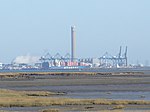Port Victoria railway station

Port Victoria railway station is a disused station in Kent, United Kingdom, which opened on 11 September 1882 and closed in 1951. It was located at the head of a 400-foot (120 m) long timber pier reaching in the River Medway estuary. The pier was discovered to be in need of repairs in 1896, and had also been damaged by a storm in November of that year. Between 1900 and 1903, the station was heavily used, as owing to a fire Queenborough pier was unavailable for use. During World War I the Admiralty took over Port Victoria. In 1916, the railway along the pier was shortened to 93 feet (28 m) and a new station building provided, the old one being demolished. By 1931 further deterioration of the pier made it unsafe and a new station was built on the landward side. The train service by this time being just two passenger services per day. In 1941 the pier was demolished and the station closed on 11 June 1951. The station featured in two Pathé News films recorded in 1939 and 1947, both featuring Station Master Stephen Mills.
Excerpt from the Wikipedia article Port Victoria railway station (License: CC BY-SA 3.0, Authors, Images).Port Victoria railway station
Port Victoria Road,
Geographical coordinates (GPS) Address Nearby Places Show on map
Geographical coordinates (GPS)
| Latitude | Longitude |
|---|---|
| N 51.432 ° | E 0.7027 ° |
Address
Jetty 8
Port Victoria Road
ME3 0AR , Isle of Grain
England, United Kingdom
Open on Google Maps








